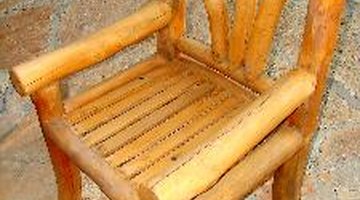How to Bend Tree Limbs for Furniture
Bent wood furniture looks nice in a summer cabin, garden patio or in any rustic decor scheme. Intermediate woodworkers will enjoy the challenge of steam bending tree limbs or branches for furniture. You can also use steam bent wood to make frames for Ojibwa style snowshoes.

Things You Will Need
- Wood to bend
- Form
- Steam box
- Teakettle
- Heat source
- Hose
-
Select your wood to bend. You can work easiest with fresh cut, green tree branches. Try to harvest the wood on the same day you plan to bend it. You can also soak wood that is too dry overnight.
-
Create a form for bending the wood. A form is a flat plank with braces attached to guide the wood into the desired curvature.
-
Build a steam box. You can make a steam box with metal or scrap wood. It should be as long as the wood you want to steam. Do not make it too much bigger, so that the steam can build up inside. Build a door on one end to bring the wood in and out and add some kind of stand or prop on the inside to hold the wood aloft so that the steam can penetrate it on all sides. Drill a few small holes in the steam box to allow for pressure release, and one larger hole for the hose.
-
Connect a heatproof hose between the steam box and the spout of a teakettle.
-
Fill the teakettle with water and place it on a heat source, such as a hot plate. Open flames can be dangerous in an enclosed wood shop, but are relatively safe in an open setting outside.
-
Allow the steam box to fill with steam. Steam should be billowing out the cracks and holes.
-
Insert the wood into the steam box and shut the door. Steam larger branches for one hour for every inch of thickness and smaller twigs for 15 or 20 minutes. Make sure your teakettle is large enough so that you don't run out of water.
-
Remove the wood from the steam box and quickly bend it around the form created in step two. You'll only have a few seconds before the wood starts to stiffen again.
-
Allow the wood to dry on the form for at least one hour, but preferably overnight, until it is completely dry.
References
Writer Bio
Heidi Almond worked in the natural foods industry for more than seven years before becoming a full-time freelancer in 2010. She has been published in "Mother Earth News," "Legacy" magazine and in several local publications in Duluth, Minn. In 2002 Almond graduated cum laude from an environmental liberal arts college with a concentration in writing.
Photo Credits
- Rustic wooden chair image by Tomislav from Fotolia.com
- Rustic wooden chair image by Tomislav from Fotolia.com
More Articles



